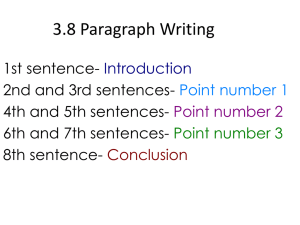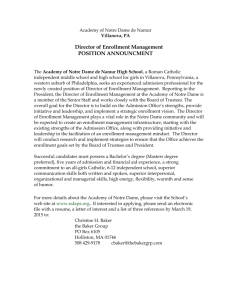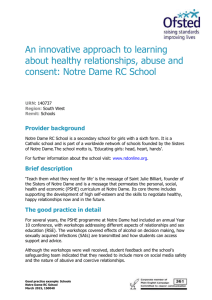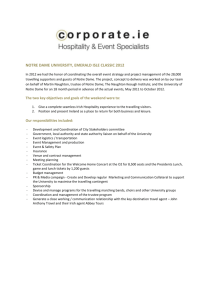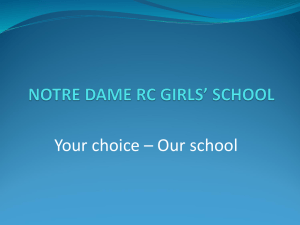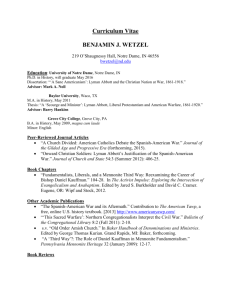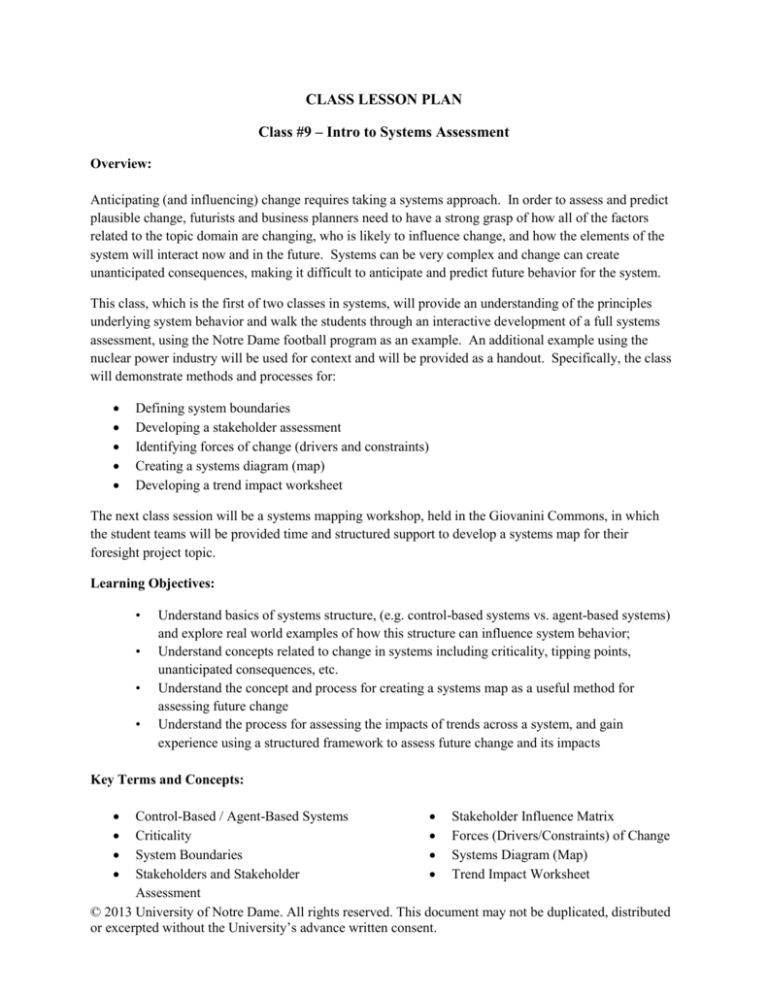
CLASS LESSON PLAN
Class #9 – Intro to Systems Assessment
Overview:
Anticipating (and influencing) change requires taking a systems approach. In order to assess and predict
plausible change, futurists and business planners need to have a strong grasp of how all of the factors
related to the topic domain are changing, who is likely to influence change, and how the elements of the
system will interact now and in the future. Systems can be very complex and change can create
unanticipated consequences, making it difficult to anticipate and predict future behavior for the system.
This class, which is the first of two classes in systems, will provide an understanding of the principles
underlying system behavior and walk the students through an interactive development of a full systems
assessment, using the Notre Dame football program as an example. An additional example using the
nuclear power industry will be used for context and will be provided as a handout. Specifically, the class
will demonstrate methods and processes for:
Defining system boundaries
Developing a stakeholder assessment
Identifying forces of change (drivers and constraints)
Creating a systems diagram (map)
Developing a trend impact worksheet
The next class session will be a systems mapping workshop, held in the Giovanini Commons, in which
the student teams will be provided time and structured support to develop a systems map for their
foresight project topic.
Learning Objectives:
•
•
•
•
Understand basics of systems structure, (e.g. control-based systems vs. agent-based systems)
and explore real world examples of how this structure can influence system behavior;
Understand concepts related to change in systems including criticality, tipping points,
unanticipated consequences, etc.
Understand the concept and process for creating a systems map as a useful method for
assessing future change
Understand the process for assessing the impacts of trends across a system, and gain
experience using a structured framework to assess future change and its impacts
Key Terms and Concepts:
Control-Based / Agent-Based Systems
Stakeholder Influence Matrix
Criticality
Forces (Drivers/Constraints) of Change
System Boundaries
Systems Diagram (Map)
Stakeholders and Stakeholder
Trend Impact Worksheet
Assessment
© 2013 University of Notre Dame. All rights reserved. This document may not be duplicated, distributed
or excerpted without the University’s advance written consent.
Class Preparation:
Readings:
“Embracing Complexity”
“Map the System” section of Hines, A., and Bishop, P. (2006). Scanning. Thinking about the
Future (pp. 55-80). Washington D.C.: Social Technologies.
Reflect on the system in which the Notre Dame football team operates. Discuss with fellow
students on the components and forces that most influence the behavior of this system
Discussion Questions:
Consider the Notre Dame football program and where its future is headed. Consider the
following questions:
o How would you define the boundaries to the system in which ND football exists? What
should be included and what should be excluded?
o What people and organizations will influence the trajectory of the program? How much
influence do they have in affecting the program’s future? What is most important to
them?
o What trends are occurring that might have an impact on the college football system?
What forces are holding change back? (consider all DEGEST domains)
A key aspect of systems mapping is getting the level of complexity right. What types of criteria
should a foresight team use to determine what to include and exclude from a systems map on a
particular topic?
When conducting a stakeholder analysis, it is suggested that scanners pay attention to what keeps
stakeholders awake at night. What value can be gained from this type of assessment?
A well-developed systems map combines lists of factors with visual representations of the
system. What is the purpose and benefit of these visual representations?
Assignment Due:
First Round Scanning Hits Due by ______________________.
© 2013 University of Notre Dame. All rights reserved. This document may not be duplicated, distributed
or excerpted without the University’s advance written consent.
INSTRUCTOR GUIDELINES
Discussion Launchers:
Notre Dame football, it could be argued, is at a crossroad that may determine if it returns to the glory of
the past or slides towards the middle of the pack. A brief history of the team will be used to launch into
an interactive exploration on how the system in which ND football exists will help to define the future
path for the program.
Discussion Questions with Answers:
Consider the Notre Dame football program and where its future is headed. Consider the
following questions:
o How would you define the boundaries to the system in which ND football exists? What
should be included and what should be excluded?
A: There are multiple levels of boundaries to consider. You will want to frame the
system at the organizational, operating environment and macroenvironment levels. At
the organizational level, for example, include players, coaches, administrators,
fans/donors, the stadium crew. At the operating environment level, the system extends to
the NCAA, the TV networks, other universities, potential recruits, NFL scouts, sports
reporters, TV advertisers. At the macroenvironment level, you should include other
sports such as baseball and basketball, equipment suppliers, high schools, the Olympics.
o
What people and organizations will influence the trajectory of the program? How much
influence do they have in affecting the program’s future? What is most important to
them?
A: Creating a list of stakeholders is an important step. For this system, stakeholders
would include many from the list mentioned above: players, coaches, NCAA, TV
© 2013 University of Notre Dame. All rights reserved. This document may not be duplicated, distributed
or excerpted without the University’s advance written consent.
networks, etc. Once you create the list, you will want to develop and influence matrix.
Here is a sample for the ND example:
o
What trends are occurring that might have an impact on the college football system?
What forces are holding change back? (consider all DEGEST domains)
A: Trends/drivers would include overall increases in player size and strength, increasing
popularity of southern (warm weather schools), the adoption of the BCS/playoff model,
expanding TV coverage of rising programs, etc.
Constraints would include the weather profile of ND, the high academic barrier to
admittance, high ethical standards of the university, etc.
A key aspect of systems mapping is getting the level of complexity right. What types of criteria
should a foresight team use to determine what to include and exclude from a systems map on a
particular topic?
A: The key considerations as you consider what to include and exclude from the systems
assessment are the likelihood of creating an impact on the system and the magnitude of the
impact should it occur. As we consider stakeholders, we look at their impact on two dimensions:
interest in the system and power to influence change in the system. We use the Influence Matrix
to assess these aspects. In business examples, it is common to look at stakeholders across “areas
of activity”: raw materials supply, manufacturing, distribution/logistics, retail/point of purchase,
use phase, end of life.
For forces of change, we explore across the full range of DEGEST categories and create a
matrix/worksheet that explores forces of change, their trajectory (how they are trending),
stakeholder influence on the force, and what impact the force will create on the system. See
example below regarding the nuclear power industry (full nuclear power example available as a
handout).
© 2013 University of Notre Dame. All rights reserved. This document may not be duplicated, distributed
or excerpted without the University’s advance written consent.
Force Field Analysis
Scope of Topic
Force of Change
Nuclear Power Sector in U.S.
Trajectory
Impact on Status Quo
Advanced by population and
GDP Growth (linear)
Drives demand for all types of generation capacity
Growing Energy Demand
Dampened by Efficiency and
Conservation (linear)
Fossil Fuel Recovery Technologies
Active Debate over Regulatory
Frameworks
Globalization
Existing Infrastructure +
Powerful Incumbents
Disruptive change that is now
widely available
Mostly creates "On-Peak" Demand - more need for "Peaker Plant" supply
Dramatic increase in proven reserves and supply - greatly reducing costs
Potential to create "Energy Independence" for North America
Highly Uncertain,
Would limit supply and increase costs of Fossil Fuels
Obama Advocacy, Washington
Gridlock,
Would create advantage for low-emission sources - renewables and nuclear
New EPA authority
Competitive forces exacerbate job loss --> economy seeks low energy costs to regain momentum
Linear growth in emerging
economies
Accelerates energy demand growth in emerging economies --> could drive up cost of fossil fuels in
U.S.
Slows adoption of new technologies such as smart grid and renewables
Constraints on system
Disfunctional government programs preserve externalities and skew investment
Rapid reversal of nuclear as preferred Clean Energy source
(Renewed) Public Fear of Nuclear
Safety
Steep increase after Fukushima
Early retirement of much nuclear capacity - transition back to fossil fuels
Daiichi
Uncertainty over investment "oxygen supply" for next generation nuclear tech
Geopolitical Turbulence
NIMBY
R&D Investment
Increasing tension with
possibility of "Flash Point"
event
Contraint on development of
infrastructure of any type
Surge due to Obama clean
energy agenda
Steady VC interest
Recent surge since 2012
Tension with oil producing countries - mostly OPEC and middle east, also Russia
Major tension over nuclear proliferation - especially Iran and N. Korea
Places higher value on efficiency and conservation to reduce need for new infrastructure
Added emphasis on smart grid and distributed generation (e.g. rooftop solar)
Drives progress in feasibility and cost - in both generation and end user efficiency
Renewables still require subsidies and RPS provisions to justify
Fear of being left behind fuels nationalistic perspectives - fuels public subsidies
Would drive dramatic demand growth for electricity
Adoption of Electric Vehicles
Still highly uncertain
Could also serve as storage infrastructure in smart grid system
When conducting a stakeholder analysis, it is suggested that scanners pay attention to what keeps
stakeholders awake at night. What value can be gained from this type of assessment?
A: Once the level of stakeholder interested and influence are determined, it is important to
understand what will drive decision making at those highly interested and influential
stakeholders. For example, the coal industry and the wind industry may be identified as
important stakeholders in an assessment of the future of the nuclear power industry. However
each will have a very different agenda for how they intend to leverage their influence. So
understanding what is most important to the CEO of a coal mining company will provide insight
into how their influence is likely to pressure future change in the system.
A well-developed systems map combines lists of factors with visual representations of the
system. What is the purpose and benefit of these visual representations?
Visual representations (diagrams, maps, etc.) serve two main purposes. First, they are effective
and exploring and understanding how relationships and interconnectivity behave in the system.
These relationships are as important that the list of stakeholders and forces themselves are. The
© 2013 University of Notre Dame. All rights reserved. This document may not be duplicated, distributed
or excerpted without the University’s advance written consent.
second benefit of creating diagrams is that it moves the analysis process from the analytical side
of the brain to the special and creative side – which helps to broaden the perspective of analysis
and can yield new insights on the topic.
Class Timeline:
5 Minutes – Quote of the Day and Intro
15 Minutes – Systems Structure and Dynamics
45 Minutes – Systems Mapping and Impact Analysis
o 10 Min – Intro to Systems
o 10 Min – Developing a Stakeholder Assessment
o 10 Min – Creating a System Diagram
o 10 Min – Developing a Trend Impact Matrix
o Use ND Football program as interactive class exercise throughout each sub-section
5 Minutes – Discussion of Force Field Analysis and Systems Mapping Workshop (in next class)
5 Minutes – Wrap Up
Classroom Activities / Short Assignments:
The systems portion of the class will be a highly interactive systems mapping experience having
the students develop a systems map (stakeholder assessment, systems diagram, trend impact
matrix) to help frame how the future of Notre Dame football may unfold.
Multimedia Supplements:
Notes and Perspectives:
Use the tree metaphor to help students visualize how to prioritize the most important aspects of
the system (stakeholders and forces of change)
Use real world examples to illustrate control vs. agent-based systems
Use World3 Model to illustrate criticality
© 2013 University of Notre Dame. All rights reserved. This document may not be duplicated, distributed
or excerpted without the University’s advance written consent.

